So, why do guitar amps have two inputs? This question often confuses most beginning players. In this article, I’ll reveal everything you need to know about amplifier inputs and how they work with channels to give your guitar the best possible sound and performance!
Keep reading to learn more!
You can use the table of contents below to take you to the area that interests you. Click on the little box to open it, and then click on the section of the article you want to read, or you can read from start to finish if you want the full guitar input experience!
The Short Answer
Two inputs allow you to connect various guitars and effect pedals to get the best sound and performance out of the amplifier. Input One is usually best for a guitar with single-coil pickups, while Input Two may sound better when using double-coil and active pickups. Ultimately, choose the guitar input that sounds best with your equipment.
Keep On Reading (Below) To Learn More
What Is An Amplifier Input?
Every guitar amplifier has at least one ¼ inch input jack, where you plug in your guitar cable (also called a cord) to connect your guitar.
Some guitar amplifiers have more than one input. For example, the Fender Princeton Reverb amp shown below is a single-channel amp that has two instrument inputs (numbers 1 and 2).
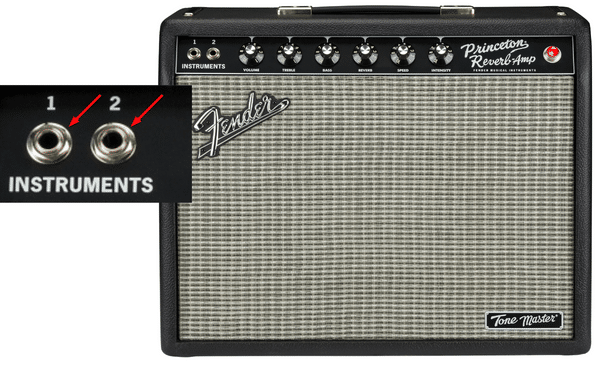
Input Naming Conventions
Guitar amplifiers that have two inputs may be named in various ways. For example, they may be called input 1 and 2 or the high and low input.
I have even seen inputs labeled normal and bright input, although this typically refers to the differences in an amplifier’s channels.
The Guitar Plug
Most guitar amplifiers require a cable with a standard (single-channel) guitar plug. So a guitar cable has a ¼ inch plug on each end with a TS (tip sleeve) configuration. The plug on one end connects to the amplifier input, and the other end connects to the guitar.
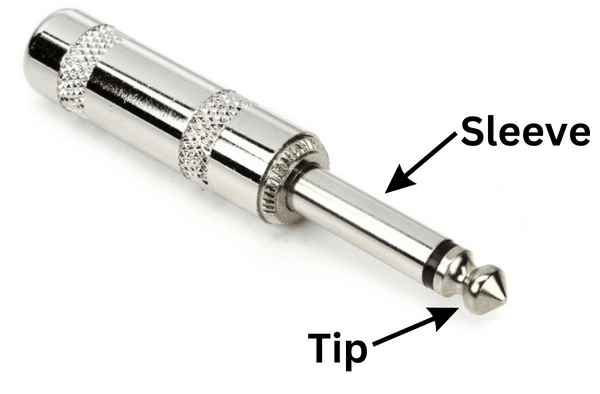
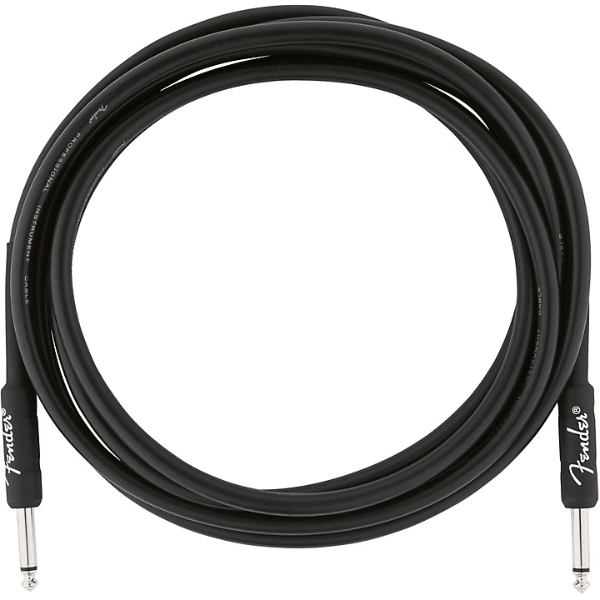
Guitar Amplifier Input Comparison

This table gives some general characteristics of the two input types on a guitar amp. You can click on each comparison in the left column to learn more.
| Comparison | Input 1 | Input 2 |
|---|---|---|
| Impedance | Higher | Lower |
| Guitar Pickups * | Passive/Active | Active |
| Effect Pedals * | Time-based effects | Dirt effects |
| Amp Channels | One and two-channel amps | Some two-channel amps |
Keep On Reading (Below) To Learn More About Each Topic
What’s The Point Of Having Two Amp Inputs?
Two inputs are usually more common in older-style tube amps, but they can be found in reissue models and some newer amps. They allow the player to connect different instruments to the same amplifier, either separately or simultaneously.
Technically speaking, the first input is usually the high-impedance jack, and the second one is low-impedance. Electrical impedance is essentially resistance to an Alternating current (A.C.).
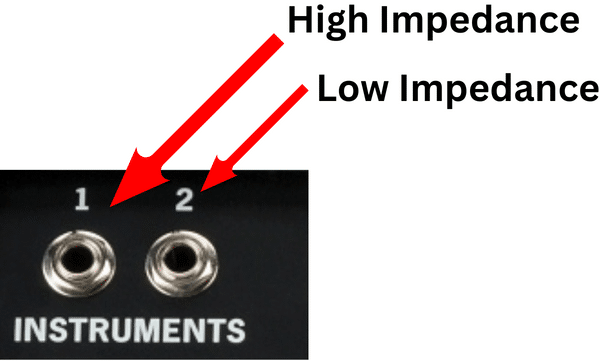
If you have an amp with two inputs in the same channel, you have probably noticed that your guitar sounds louder and maybe even brighter when plugged into Input One. This is because Input Two typically has a 6 -10 dB volume cut.
What Is Headroom?
Headroom is another technical term that is essentially the loudest volume the amplifier will give you without distorting the sound. For example, the much louder volume you get when you strike the strings really hard with a guitar pick without the sound breaking up.
Plugging the proper type of instrument into input jack one or two can give you the best headroom. You can read more about that in the next section.
Can You Use Both Inputs At Once?
Yes, you can use both inputs at once if you need to. For example, some players may use input one for their guitar and input two for a microphone. It all depends on your particular needs and the equipment you have available.
If there are two guitar players, it’s better for each player to have their individual guitar amplifier to get the ideal sound. A PA system is the best place to plug in all microphones.
Where To Plug In Your Guitar And Pedals
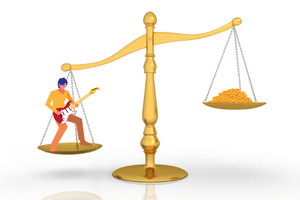
The instrument input you use depends, to an extent, on the kind of guitar and effects pedals you have. There are no rules chiseled in stone. It definitely requires a bit of experimentation to get the guitar sound and performance you’re looking for.
However, here are some things to keep in mind with the various types of guitar pickups and effect pedals.
Guitar Pickups
Your guitar’s pickups can have an impact on signal strength
Single Vs. Double-Coil Pickups
Single-coil players will most likely want to plug into input 1 to compensate for their pickups’ lower output. Also, this is the way to go if you’re trying to drive the front end of your amp to get a mild breakup at higher volume levels.
Double-coil (humbucker pickups) might sound better in input 2 if you’re looking for a clean sound with the guitar’s volume controls turned way up. For example, input 2 could come in handy for a Jazz player with humbucking pickups looking for a mellow sound with a small amplifier turned up all the way to be heard in a large auditorium.
However, if you want your humbuckers to push your amp into natural distortion, definitely go with input 1!
Passive Vs. Active Pickups
The other thing to consider is your pickup type.
Most pickups are passive, which means that the signal output comes directly from the magnetic pole pieces and coil winding. Passive pickups can be single or double-coil designs.
Active pickups have an electronic circuit that increases the pickup’s signal strength and provides tone equalization (EQ). They can also have a single or double-coil design.
Most Metal and Rock players plug active pickups into input 1 to get a more aggressive sound. However, if you’re using active pickups to get a clean sound with a wider tonal variation, you’ll probably want to plug your guitar into input 2.
Effects Pedals
Time-Based Effects
Time-based effects like Delay, Reverb, Phaser, Chorus, and Flanger should be put in your amplifier’s effects loop.If you don’t have an effects loop and don’t use dirt pedals, you might be better off plugging them into input 2. This will help control the noise in your playing, especially if you have several pedals on at once.
If you want to get overdrive and distortion from your amp settings, the way to go is to plug your time-based pedals into input 1.
Dirt Pedals
Dirt pedals like Overdrive, Distortion, and Fuzz are probably better off in input 1. This will allow you to drive the front end of your amp as hard as possible. Most Rock and Metal players using an amp without an effects loop will run all their pedals through input 1.
You can always add a noise gait pedal to the signal chain if things become too noisy.
Related Article ➡ Pedal Vs Amp Distortion And Overdrive – Which One Is Best?
Do The Number Of Amplifier Channels Matter?
The answer depends on the particular type of amplifier you have.
One Channel With One Input
Here is my vintage Sears Silvertone amplifier with a single channel and only one input. This channel configuration is the most straightforward setup you can have in a guitar amp.

Just plug in, flip the power switch, set the amp volume, and you’re good to go! The guitar controls all the other settings. So you don’t have to be concerned with input impedance, etc. It’s a real players’ amp.
These kinds of amps started the whole Electric Blues sound because they were very low wattage. To be heard, the player had to turn to volume all the way up, and it would have that “nasty” sounding breakup. Think early John Lee Hooker!
One Channel With Two Inputs
This “Blackface” Fender Princeton reverb has one channel with two instrument inputs. The same amplifier settings (volume, treble, etc.) control both inputs. It also gives you a two-band EQ with reverb and tremolo.

With a low-wattage amp like this, you can easily hear the difference between a single-coil and a double-coil (humbucker) pickup guitar plugged into input one, especially if the amp’s volume is cranked.
Two Channels With Two Inputs
This Fender Twin Reverb amplifier has two non-switchable channels, one Normal channel, and one Vibrato channel. Each channel has two inputs. Each channel’s setting knobs and “Bright” switches control the sound from inputs 1 and 2.

The channels have to be manually switched, which means you have to unplug the guitar from the Normal channel and plug it into the Vibrato channel or vice-versa.
I used one of these amps for years when I first started playing, with a Fender Stratocaster guitar plugged into input one of the Vibrato channel. I gave my guitar reverb and mild overdrive with the amp cranked, but boy, was it loud!
The benefit of this type of amp setup is that you can have one guitar plugged into each channel.
My uncle played Country music through the same amp. He played lead guitar plugged into input one of the Vibrato channel, and his rhythm guitar player plugged into input one of the Normal channel. Since this amp is 85 Watts RMS, both players sounded good!
With an amp of this power output, you can get a clean sound out of a humbucker pickup plugged into input one if the amp volume knob is not set too high.
Two Channels With One Input
This Marshal JCM 900 amplifier has two switchable channels. Each channel gets its audio signal from a single instrument input. The channels can be switched using a foot switch or the push button on the front panel.

This amp only needs one instrument input because it’s designed for Rock and Metal players that want anything from clean or creamy overdrive to full-on distortion.
So, for example, channel one can be set for crunchy power chords, and channel two can give killer lead tones. To clean up the guitar’s sound on channel one, the player would turn down the volume on the guitar.
The JCM800 and 900 amps helped usher in the age of 80s big hair Metal!
Trying Different Inputs Is Key!

As I mentioned above, if your amplifier has more than one instrument input, it’s best to try your guitar and effects pedals in each one until you nail down the sound you’re looking for. Of course, this can vary, depending on many factors, so always be open to trying new things!
Some things to consider are choosing your instrument input are:
- Your playing style (pick vs. fingers)
- The type of music you play (Jazz vs. Metal, etc.)
- Your guitar’s pickups (single-coil vs. humbucker)
- The amplifier you plug into
- Amplifier output volume
- Effects pedal performance
- Audio signal noise (signal to noise ratio)
Can Using The Wrong Input Damage Your Amp?
No, the signal from your guitar and effects pedals can be put into any input jack without damaging your amplifier.
However, be aware that if you push your amp too hard, you may cause some speaker damage, especially if you’re using a speaker cabinet that is under-rated for your amp’s output power.
I wrecked a lot of speakers playing in high school bands by pushing my cabinets to the max with dirt pedals.
So don’t be afraid to use the instrument input that sounds best to you. That’s what they’re there for!
What About Channel Jumping?
Some players use a short jumper cable to connect two inputs of a double-channel amplifier.
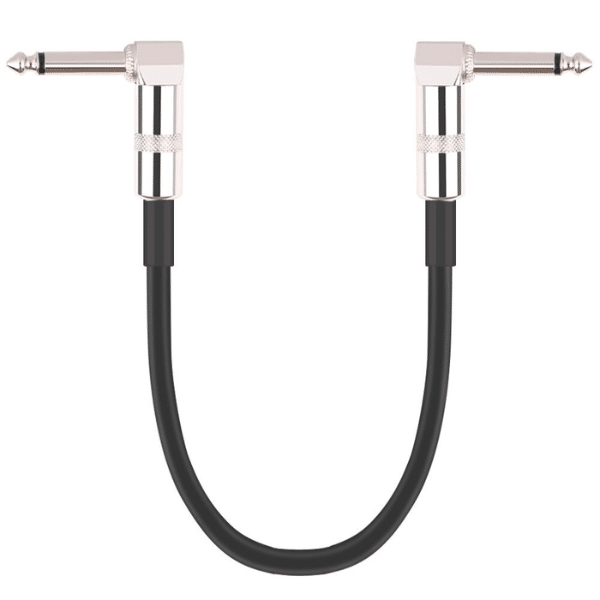
To do this, you need to have two instrument inputs for each channel (four inputs total) so that you have two open inputs, one of which can be used to plug in the guitar.
Jumping the channels can give the amplifier an “edgy,” mildly overdriven, or even a distorted sound. Ritchie Blackmore famously jumped the channels on his Marshall 100-Watt Super Lead Plexi amps to get his iconic sound in Deep Purple!
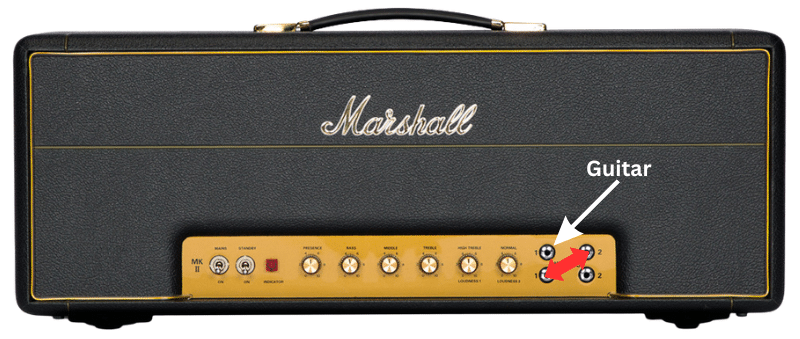
You can do the same thing with a Fender Bassman amplifier to give you that famous Bassman sound on steroids!
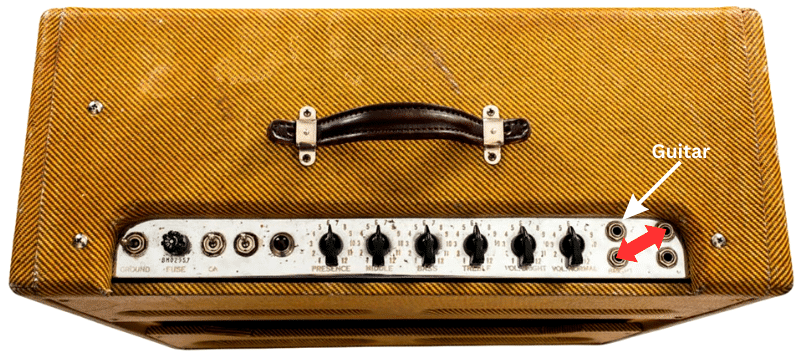

Be aware that not all amplifiers are made to handle channel input jumping. You could overheat and damage the amplifier, especially with tube amps. Therefore jump your amplifier at your own risk! If you’re not sure, it’s best to contact the manufacturer to ensure that the amp can be channel-jumped without causing a problem!
Frequently Asked Questions

Here are some of the questions I get asked about guitar amplifier inputs.
If your question does not appear here, please put it in the comments, and I will get right back to you with an answer.
Can I Use Both Amp Inputs At The Same Time?
Yes, you can use both inputs to plug in two guitars or a guitar and a microphone. However, if your amplifier is underpowered, you may have a volume problem. You will likely need a 50 to 100 Watt amplifier for professional-sounding results.
Can You Split-Input An Amp?
Yes, you can use a signal splitter on the end of your guitar cable to plug your guitar into both channels of an amplifier. However, I don’t recommend this. You’re better off trading your amplifier in for something more suitable to your playing style or volume requirements.
I played through a CBS Fender Bassman amp using both channels with a split guitar cable to get more volume back in high school. Unfortunately, the clean sound of my guitar did not sound as crisp, but it gave me the extra punch I needed.
Why Is My Guitar Amp Input Jack Not Working?
You may have a broken input jack, or the contact points could be dirty (oxidized). Try plugging into a different input if you have more than one available. If you are still not getting sound, there could be something else wrong with your amplifier, speakers, guitar cable, or guitar.
How Do You Fix An Amp Input Jack?
The input jack may need to be deoxidized or replaced.
I don’t recommend you open your guitar amplifier to fix the problem. You could get electrocuted and be hurt severely or die, even if the amplifier is unplugged, since components like capacitors can store energy. Instead, it’s better to bring the amp to a certified repair technician.
What’s The Difference Between Input And Output Jacks?
Audio input jacks carry the guitar’s audio signal into the amplifier. Audio output jacks usually send the sound from the amplifier to the speakers.
How Many Guitars Can You Plug Into One Amp?
You can plug as many guitars into your amplifier as there are input jacks. However, I recommend plugging one guitar into the amp for the best sound, even if you have more than one channel. You can choose the channel that best fits the sound you want.
Final Thoughts

I hope this article on why do guitar amps have two inputs helps you get the most out of your amplifier or narrow down your choices of what amp to buy!
Each amplifier can have a unique instrument input design that depends on its circuitry and the number of channels. So it’s essential to understand these basic principles to get the most out of the amplifier’s performance and the best sound.
Two amplifier inputs allow you to match the signal strength of various guitars, effect pedals, and microphones.
Input one usually has a higher impedance than input two. Therefore, while guitars with single-coil pickups usually sound best in input one, double-coil and active pickups may sound better in input two.
It’s always best to experiment to find the ideal input for your guitar and effects pedals! If your guitar amp has more than one channel, plug it into the one that gives you the sound you’re looking for. Some multichannel amps allow you to switch channels without unplugging your guitar by using a footswitch.
Use caution when jumping the inputs of a two-channel amp to avoid damage to its electronic circuitry and speakers!
Related Article ➡ Why Do Guitar Amps Have 2 Channels? – Are 2 Better Than 1?

Here is a video from 300Guitars that shows you one way to clean the input jack on your guitar and guitar amplifier. Check it out!
Tell Me What You Think

Please leave a comment below if you enjoyed this article, have any questions about guitar amp inputs, or want to give your point of view. I will be happy to help you.
- How many inputs and channels does your amp have, and how do you connect your guitar?
- Do you favor a single amp input with one or more channels? Why?
- Has this article helped you understand your amplifier or choose an amp to purchase?
- What else is on your mind?

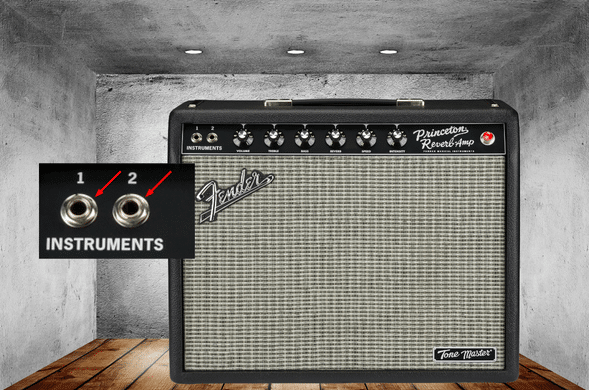

Hey!
I’ve always wondered why guitar amps have two inputs, so this article was super helpful! I had no idea that the different inputs were designed for different levels of guitar output, and that using the wrong input could affect the sound quality. It’s great to have a better understanding of how guitar amps work, especially if you’re a beginner or just getting started with playing. Thanks for breaking it down in a way that’s easy to understand!
Hi, Jennyse
Thank You for your comments!
Yes, it’s not a critical factor, but using the proper amplifier input can make the difference between good and great sound!
It’s always a good idea to understand how to optimize your amplifier settings for your playing style and genre as well as the equipment you plug into it. 😎
Rock On! 🤘
Frank 🎸
I was part of our church’s music team as one of the guitarists for more than 4 years. But all those times, I did not know so many things about amplifiers and how to set up the instruments in general. ☺ We had a sound technician to keep things in order to make sure the instruments worked.
While I always wondered why our guitar amplifier had two inputs, I never bothered to ask, lol. This information you provided is very useful because I am again involved in the music ministry at our local church and there’s no sound technician we can count on to set up the instruments and we are not sure if what we are doing is right.
We are not sure where to insert the plug for the guitar if it will work on any of them, or if it could damage the amplifier should we plug it into the wrong input jack.
The tips and guidelines you shared are much appreciated.
Hi, Alice
Thank You for your comments!
When it comes to guitar inputs, there are so many variables that can affect your choice, like the sound the audience hears, the guitar you play, effects pedals, the amplifier, and the size of the room.
One of the best ways to choose the correct input is to plug into each one and listen to the sound you get, then adjust the settings on your equipment to taste.
You can’t really hurt the amplifier, so don’t be afraid to experiment. As you become more experienced, the process will become almost second nature.
Keep playing and having fun! 😎
Frank 🎸
Hi Frank,
Quick question on channel jumping. Would you recommend to so? I am using a Fender Custom Twin. Setup is fairly simple just Strat into Klon then amp.
Btw nice website
Cheers
Peter
Hi, Peter
It’s generally safe to channel-jump a Fender amp as long as you’re only connecting inputs together and not any other jacks.
However, you should be careful because having two signals through the same amp with too much gain can damage your amplifier. This is especially true with high-gain tube amps, although it’s pretty rare. Still, best to check with Fender to be sure since you’re playing through a pretty expensive amp.
Some say that channel jumping on a Fender amp doesn’t give you as much of a boost as with a Marshall, and I tend to agree. Others say you can get a fatter tone with more gain by jumping the channels on a tweed fender.
I have a Fender reissue Bassman, and I don’t like the channel-jumped sound as much as going through the Normal channel alone, so it’s all about personal taste.
I hope this helps! Feel free to let me know if you need more info, and I’ll try to help.
Have a Rockin’ Weekend! ?
Frank ?